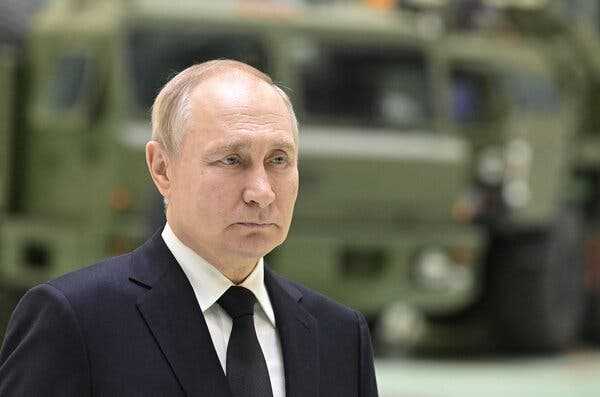The United States says Russia is not allowing American inspectors access to its arsenal to ensure compliance with the New START agreement, which the two nations renewed in 2021.
-
Send any friend a story
As a subscriber, you have “>10 gift articles to give each month. Anyone can read what you share.
Give this articleGive this articleGive this article

The full-scale invasion of Ukraine in February last year by the Russian military under the command of President Vladimir V. Putin makes any further negotiations over arms control difficult.
WASHINGTON — The State Department told Congress on Tuesday that Russia was not complying with the only nuclear arms control treaty remaining between the two nations, jeopardizing a source of stability in their relationship.
The agency said Russia had refused to allow American inspectors into nuclear weapons facilities, an obligation under the treaty known as New START, which was renewed for five years in February 2021.
“Russia’s refusal to facilitate inspection activities prevents the United States from exercising important rights under the treaty and threatens the viability of U.S.-Russian nuclear arms control,” the State Department said in a statement on Tuesday.
It added that “Russia has also failed to comply with the New START treaty obligation to convene a session of the bilateral consultative commission in accordance with the treaty-mandated timeline.”
The State Department called on Russia to return to compliance by allowing inspectors onto its territory, as it had done for more than a decade, and by agreeing to hold a session of the commission, in which officials could discuss issues related to the treaty and nuclear arms control.
The State of the War
- In the East: Russian forces are wrestling for control of villages near the beleaguered city of Bakhmut, which has become a flashpoint in a battle that Moscow views as crucial for its push to seize the Donbas region.
- In Kharkiv: Residents have slowly trickled back into Ukraine’s second-largest city after Ukrainian forces expelled the Russian military. But signs of the war — and the chance that it might return — are everywhere.
- Mercenary Troops: Tens of thousands of Russian convicts have joined the Wagner Group to fight alongside the Kremlin’s decimated forces. Here is how they have fared.
- Military Aid: After weeks of tense negotiations, Germany and the United States announced they would send battle tanks to Ukraine. But the tanks alone won’t help turn the tide, and Kyiv has started to press Western officials on advanced weapons like long-range missiles and fighter jets.
Russia announced in August that it was suspending the access of American inspectors to its nuclear arsenal. And in November, it canceled a diplomatic meeting of the bilateral commission in Cairo during which officials had planned to review compliance with the treaty. The commission last met in October 2021.
In August, Russia’s deputy foreign minister, Sergei A. Ryabkov, said Moscow was postponing the meeting because the United States “did not want to take into account Russia’s priorities, they wanted to discuss only the resumption of inspections,” the state-run RIA Novosti news agency reported.
“The situation around Ukraine also had an impact,” the agency quoted Ryabkov as saying.
After Russia’s announcement, Ned Price, a State Department spokesman, said the two nations “have continued to provide data declarations and notifications in accordance with the treaty.”
The treaty was signed in 2010, and it has ensured since 2011 that the two nations limit their strategic nuclear arsenals to 1,500 warheads each. The main verification mechanism of the treaty centers on reciprocal inspections in which each country can examine data and evidence around the nuclear arsenal.
When Russia suspended inspections, it said that U.S. sanctions imposed on Russia after it invaded Ukraine made it too difficult for its inspectors to get access to the United States. The State Department said that was false.
Updates: Russia-Ukraine War
Updated Jan. 31, 2023, 3:05 p.m. ET
- U.S. says Russia is not complying with the two countries’ last remaining nuclear arms control treaty.
- France increases its aid to Ukraine with 12 more Caesar howitzers and stepped up training.
- Fighting rages around Vuhledar, 60 miles from Bakhmut.
After the pandemic began in March 2020, the two sides suspended inspections, and U.S. officials have been saying they hope to get the practice back on a regular schedule.
The New START agreement was set to expire on Feb. 5, 2021, but the two governments announced a five-year extension two days before that deadline. The full-scale invasion of Ukraine in February last year by the Russian military under the command of President Vladimir V. Putin makes any further negotiations over arms control difficult. Since the war began, President Biden has put on hold any diplomatic discussions over new arms control treaties.
New START does not cover the use of tactical nuclear weapons. U.S. and European officials have debated whether Mr. Putin might use such a weapon in Ukraine. That possibility was intensely discussed last fall in Washington and other European capitals because of specific data from intelligence agencies, but talk of it among officials has since quieted down.
In August 2019, the Trump administration announced it was ending another arms control treaty, the Intermediate-Range Nuclear Forces agreement, after having suspended it that February. The United States had accused Russia of repeatedly violating the treaty, which had been active since the Reagan administration. U.S. officials also said they were increasingly concerned about China, which was not a party to the treaty, and insisted they did not want their ability to deploy missiles in the Asia-Pacific region to be hamstrung.
The ending of that agreement left New START as the only remaining nuclear arms treaty between the United States and Russia.
“The United States continues to view nuclear arms control as an indispensable means of strengthening U.S., ally and global security,” the State Department said on Tuesday. “It is all the more important during times of tension when guardrails and clarity matter most.”
Source: nytimes.com



